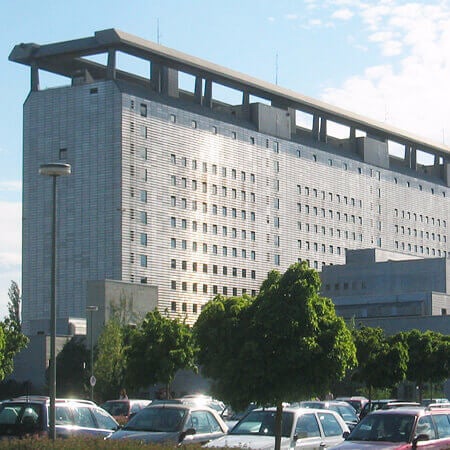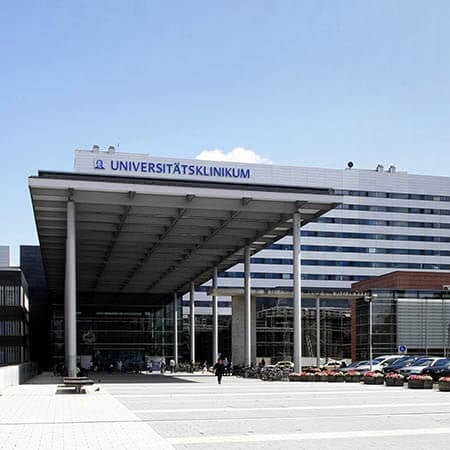According to statistics, in recent years, the number of patients with skin cancer has increased rapidly, regardless of age and gender. Despite the use of advanced examination methods and novel treatment options for skin pathologies, there is still no unequivocal answer to the question that worries everyone: is it possible to cure skin cancer? And we're here to tell you, yes, it is. But let's look at the peculiarities of skin cancer first.
Content
- Types of skin cancer
- Why does skin cancer occur?
- Symptoms of skin cancer
- Complications of skin cancer
- Surgery for skin cancer in European hospitals
- Radiation therapy for skin cancer
- Chemotherapy in European hospitals
- Prophylaxis and prognosis
- The cost of treatment in Europe
- How to start skin cancer treatment in Europe?
Types of skin cancer
Skin cancers are divided into the following types: melanoma (a type of skin cancer that arises from melanocytes); squamous cell skin cancer (usually develops from squamous cells belonging to the surface layer of the epidermis); basal cell skin cancer (formed in case of atypical degeneration of basal epidermal cells); adenocarcinoma (the rarest type of malignant tumor, which develops from sweat and sebaceous glands).
Of the total number of cases, about 10-20% are squamous cell cancers, and 60% are basal cell cancers. Since squamous and basal cell skin cancer arises from epidermal cells, such diseases are considered malignant epitheliomas.
Skin cancer accounts for about 12% of all cancer diagnoses. Dermatologists report a 4.5% increase in the incidence of the disease. Often skin cancer affects people of older age. People with light skin, people from countries with high levels of insolation (countries with a hot climate), or those who spend much time outdoors are more likely to be affected.
Why does skin cancer occur?
Among the causes of malignant tumors on the skin, prolonged exposure to UV radiation is the leading one. Approximately 92% of all cancer cases develop in exposed areas of the body – the face and neck. People with fair skin are twice as likely to be sensitive to UV radiation.
The development of skin cancer is also caused by exposure to chemicals which have a carcinogenic effect (lubricants, tobacco smoke, arsenic). Thermal or radioactive factors that affect the skin also lead to skin cancer development. The condition can develop at the burn site and as a particular case of complication after radiation dermatitis. Injury to scars (moles) can cause them to grow into malignant neoplasms.
Heredity can increase predisposition to cancer. If one family member has had a previous case of skin cancer, its recurrence is relatively high. One should also remember that skin diseases can transform into malignant tumors after a certain period, which later become skin cancer. A list of conditions that can further lead to precancerous states includes Bowen's disease, leukoplakia, erythroplasia of Queyrat, xeroderma pigmentosum, and Dubreuil melanoma, various pigmented nevi, as well as chronic skin lesions in syphilis, and trophic type ulcers.
Symptoms of skin cancer
An essential feature of the clinical picture of skin cancer is the possibility of detecting this disease at its early stages. Disturbing signs that primarily draw attention are the development of previously unobserved elements on the skin without simultaneous itching or painful sensations; changes in the previously existing skin scars, papillomas, moles (nevi), or trophic ulcers.
The development of new elements, unlike the skin manifestations of infectious, allergic, and systemic diseases, is not accompanied by any changes in the patient's general health condition.
General signs to look out for include:
- Darkening of the normal area of the skin
- Long-lasting ulceration with a crusty discharge or a moist surface
- Thickening of an area of skin with its elevation above the general surface; change in color
- Itching, redness, and thickening around the suspected area
It’s important to remember that different histological forms of skin cancer have their specific clinical manifestations.
Complications of skin cancer
By spreading to deeper skin layers, skin cancer contributes to the destruction of skin tissue. Typically, skin cancer is localized on the face, which can also affect the eyes, ears, paranasal sinuses, and even the brain, leading to loss of vision, hearing, development of meningitis, or sinusitis of a malignant nature, and damage to various parts of the brain.
Metastases spread through the lymphatic vessels, further developing malignant transformation of regional lymph nodes (inguinal or axillary). A thickening, as well as enlargement of the affected lymph nodes, may be detected. They may be painless and mobile during palpation.
Over time, adhesion of the lymph nodes to surrounding tissues may develop, causing them to lose mobility. Later on, a lymph node may disintegrate, forming an ulcer-like defect. The proliferation of cancer cells with dissemination through blood vessels can lead to the development of secondary tumors in the internal organs. The latter is often accompanied by the secondary stomach, liver, kidney, lung, and breast cancer development.
Surgery for skin cancer in European hospitals
The main goal of treating skin cancer in European medical facilities is the maximum but sparing removal of the neoplasm, which is carried out by excising the primary tumor up to healthy tissue. There are currently several types of surgery, including classical excision, Mohs surgery, electrocoagulation, cryotherapy, and laser therapy.
Classical excision is indicated in the early stages of cancer. The surgeon removes the tumor, capturing adjacent healthy skin. After surgery, the removed tissue is examined under a microscope for the presence of cancer cells.
Mohs surgery is most effective in basal cell carcinoma or squamous cell cancer. A unique feature of this surgery is the layer-by-layer removal of the tumor and immediate microscopic examination of each layer for the presence of cancer cells. Sections are made until healthy, cancer-free, tissue appears under the microscope. The surgery is performed to minimize the removal of healthy tissue and preserve the cosmetic effect.
During the reconstruction phase of Mohs surgery, which is considered the most difficult in this technique, the wound is closed based on its depth and size. If the wound is superficial, it is left for healing without additional surgery. If the volume of removed tissues is quite large, edges of the wound are stitched together, and a scar is formed. The wound can also be closed by stretching the skin: the skin is stretched over the wound, and blood supply is restored. The wound can also be closed with a skin implant: a fragment of skin that is harvested from another body area is grafted onto the wound, with no additional blood supply to the implant.
After the surgery, the doctor gives detailed recommendations to the patient. In 7-14 days, the stitches are removed, after which the patient undergoes an examination to confirm the effectiveness of the received treatments.
Electrocoagulation is also suitable to treat small squamous cells or basal neoplasms. The intervention is performed using a curette, a small spoon-shaped instrument. During the removal of the damaged tissue, an electric current is applied to the area to destroy the remaining cancer cells and prevent bleeding. Several stages of treatment are required for complete removal.
Cryotherapy (cryosurgery, cryodestruction) is used to remove Kaposi's sarcoma, melanoma, basal cell carcinoma, or squamous cell cancer when the neoplasm is small. The essence of the surgery is to remove the cancerous formation with liquid nitrogen, which is applied directly to the lesion site. As a result of shock freezing of the tumor, the cancerous cells are destroyed, but there may be damage to nerves, which often leads to loss of sensitivity in this area.
Laser therapy includes modern and highly effective treatments because the layer-by-layer removal of diseased tissues is carried out with high precision and without damaging healthy tissues. Laser therapy is performed quickly and requires only local anesthesia.
Radiation therapy for skin cancer
Doctors often treat skin cancer with laser therapy. But if the lesion is extensive, combined treatment options with distant gamma therapy are indicated.
Radiation treatments are also indicated at the early stages of cancer or after surgical removal of squamous cells and metatypical cancer in the case of its recurrence. Radiation therapy has a good effect because cancerous cells are destroyed with the help of radio beams, so they stop multiplying and die. In some clinical situations, radiotherapy is prescribed in combination with chemotherapy. Patients who are treated with chemoradiotherapy are more likely to demonstrate sufficient response.
Radiotherapy is prescribed to older adults if the primary tumor is up to 20 mm in size. In this case, a tolerated dose of radiation is chosen. It is calculated individually for patients. The advantage of radiation therapy is the destruction of cancerous cells and the preservation of healthy, intact cells. However, local complications such as perichondritis, dermatitis, and conjunctivitis may develop after radiation therapy.
If patients are diagnosed with melanoma, radiation therapy is prescribed at the stage of tumor progression, and only in combination with chemotherapy or immunotherapy, since melanoma often demonstrates resistance to radiation.
With Kaposi's sarcoma, namely, large painful lesions, patients are treated with local radiation exposure. However, this is only indicated for HIV-infected patients. For AIDS patients, it is almost impossible to achieve the desired result.
Chemotherapy in European hospitals
Chemotherapeutic method is one of the most common and effective treatments for skin cancer. It is prescribed for all possible forms of skin cancer. Chemotherapy is especially effective when a relapse occurs or when the tumor is of critical size, preventing surgery. In this case, chemotherapeutic agents destroying tumor cells are prescribed.
For basal cell tumors, topical chemotherapy is prescribed with an external ointment containing prospidine or fluorouracil. It should be applied twice a day topically, for several weeks. Most often, chemotherapy involves topical applications with cytostatics.
To know how to cure squamous cell skin cancer with chemotherapy, it is necessary to determine the stage of the process since this method is effective only for small tumors or recurrences. The patient receives topical chemotherapy with fluorouracil ointment. Otherwise, highly effective chemotherapy drugs are indicated.
Doctors treat metastatic cancer of the epidermis, which can cause skin lesions of the nose, cheeks, and forehead, in the same way as squamous cell cancer, since the clinical manifestations of both forms are almost similar.
For melanoma treatment, chemotherapy is not indicated or is indicated at the advanced stage of the disease, when numerous metastases occur, and the primary tumor reaches a critical size. Destruction of cancer cells in primary and secondary tumors occurs faster when chemotherapy is applied directly to the tumor.
Prophylaxis and prognosis
The best prevention for skin cancer is to protect the skin from adverse factors (ultraviolet rays, radiation, chemical, traumatic and thermal factors). Doctors strongly recommend avoiding direct exposure to sunlight and sunscreen if exposed to the sun. Workers in the chemical industry and those directly exposed to radioactive substances must follow safety rules, using all kinds of protective equipment.
Patients with a predisposition to cancer or obvious precancerous skin diseases need to monitor their health condition. Regular examinations by a specialist are necessary because they facilitate timely detection of possible occurrence of cancerous neoplasms. For instance, choosing the correct therapy is a way to prevent transforming melanoid nevi.
The prognosis for recovery depends primarily on the type of skin cancer and the degree of differentiation of the tumor cells. For example, basal cell skin cancer is characterized by a benign course (without metastasizing) and is associated with a favorable prognosis. In case of timely treatment start, the survival rate after elimination of squamous cell skin cancer is about 96%. Patients who suffer from melanoma have the most unfavorable prognosis. Among them, the survival rate is 50-51%.
The cost of treatment in Europe
Treatment of skin cancer in Europe is highly effective, and most cancer types are curable there. The administration of innovative treatments in combination with radiation therapy and surgery leads to good results in skin cancer treatment. Therefore, the price of skin cancer treatment in Europe will depend on both its form and stage and the applied treatment methods. It is important to note that prices for treatment in Europe are much lower than it might be expected:
- The cost of Mohs micrographic surgery for skin cancer ranges between 4,700 EUR and 7,600 EUR.
- The cost of laser surgery for skin cancer ranges between 5,000 EUR and 8,300 EUR.
- The cost of cryosurgery for skin cancer ranges between 5,100 EUR and 8,300 EUR.
- The cost of photodynamic therapy (PDT) for skin cancer ranges between 5,100 EUR and 8,000 EUR.
To find information about the cost of skin cancer treatment in the country of interest, visit the Booking Health website.
How to start skin cancer treatment in Europe?
Skin cancer treatment in Europe offers a real chance to recover and avoid cosmetic defects. The great experience of doctors and the latest equipment make it possible to carry out rapid examinations and immediately prescribe individual treatment. During treatment, patients stay in comfortable conditions of the European hospitals, and attentive and benevolent personnel contribute to good mood and speedy recovery.
Going for treatment in Europe with Booking Health, foreign patients do not need to worry about tickets, transfers, and accommodation, as all organizational issues are under the control of Booking Health. Our company cares about each of its patients: each person coming for treatment in the leading European hospitals is accompanied by a personal interpreter if one is needed.
Booking Health also guides you through your treatment options and helps you choose the right clinic for you among the world’s leading hospitals.
So, all you need to do to get started is fill out a request form on the Booking Health website. Booking Health specialists will provide you with information and assistance as soon as possible.
Authors:
The article was edited by medical experts, board certified doctors Dr. Nadezhda Ivanisova and Dr. Sergey Pashchenko. For the treatment of the conditions referred to in the article, you must consult a doctor; the information in the article is not intended for self-medication!
Our editorial policy, which details our commitment to accuracy and transparency, is available here. Click this link to review our policies.
Sources:
National Cancer Institute
Mayo Clinic
Canadian Cancer Society



















